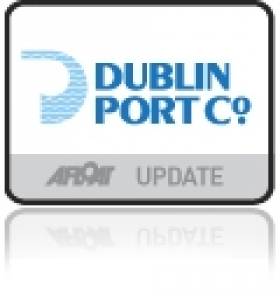Displaying items by tag: Dublin Port & Docks Board
Former Dublin Port Tug on Delivery Voyage to Portugal
#SOLD DUBLIN TUG SETS SAIL – With a career spanning nearly four decades, the former Dublin Port Company tug Ben Eadar (1973/198grt) departed over the weekend on her delivery voyage to serve new owners in Portuguese waters, writes Jehan Ashmore.
Prior to her departure, Ben Eadar was moored alongside the grab-hopper dredger Hebble Sand (1963/757grt) in Alexandra Basin, which too awaits her delivery voyage to new owners.
It was envisaged that the veteran tug would be towed on the delivery voyage to Portugal however she left Dublin Port for the final time on Saturday under her own power. Since her departure the 17 tonnes bollard pull (tbp) veteran vessel called en route to Milford Haven on Monday before making a longer leg across the Bay of Biscay.
She still retains her original name since her launch at the Yorkshire shipyard of Richard Dunston Ltd, Hessle, however she was re-flagged in Vanuatu, where her change of registry is Port Vila, the capital of the south Pacific island nation.
Ben Eadar became the last of three tugs sold this year to depart Dublin Port, having been brought by ARPA & Co. of Setubal in Portugal. The 17-tonnes bollard pull (tbp) tug follows her younger 35tbp Voith- Schneider fleetmates, Cluain Tarbh (1991/268grt) and Deilginis (1997/335grt). The former was sold to Scottish interests and the latter remains in Irish waters based out of Killybegs.
The trio represented the last of the older generation of a tug fleet built for the Dublin Ports & Docks Board (DP&DB) which is now the Dublin Port Company. The tugs were all given names of Dublin Bay coastal suburbs spelt in Irish and were replaced by a pair of more powerful 50tbp newbuilds introduced from 2009.
Dublin Port Tug Trio For Sale
The smallest of the tugs for sale is the 17-tonnes bollard pull Ben Eadar (1972/198grt) which was built by Richard Dunston (Hessle) Ltd. She is berthed elsewhere in the port alongside the former Dundalk Port Company owned dredger Hebble Sand, which too has been recently put up for sale. For more information about the grab-hopper dredger click HERE.
Ben Eadar was decommissioned in 2009 and her 35-tonnes bollard-pull fleetmates Cluain Tarbh (1991/268grt) built by McTay Marine of Bromborough and Deilginis (1996/335grt) remained in service until late last year.
Of the trio Deilginis is the last tug commissioned by the Dublin Port & Docks Board (DP&DB) and the 30m tug is also the last to carry a traditional naming theme based on Dublin Bay coastal suburbs spelt in Irish. Deilginis is the Irish for Dalkey, Cluain Tarbh is for Clontarf and Ben Eadar is a translation for Howth.
Deilginis was launched from Astilleros Zamakona S.A. in Bilbao, the same Spanish shipyard that was commissioned by the Dublin Port Company to build two 50-tonnes bollard pull tractor tug sisters. The first newbuild Shackleton entered service late last year and she was followed by Beaufort in early 2010. In March of that year the tugs that cost €6m each to build were officially named in a joint ceremony.
- Dublin Bay
- Clontarf
- Dublin Port Company
- Dundalk Port Company
- howth
- dalkey
- Port of Dublin
- Ports and Shipping News
- Dublin Port Tugs
- Deilginis
- Cluain Tarbh
- Ben Eadar
- Dublin Port & Docks Board
- Hebble Sand
- Dredger for Sale
- VoithSchneider trator tugs
- EastLink bridge
- North Wall Extension
- Dublin Bay suburbs
- McTay Marine
- Richard Dunston (Hessle) Ltd
- Astilleros Zamakoza S.A. Bilbao






























































